 Leading Blog | Posts by Month |
 Leading Blog | Posts by Month |
12.31.17

LeadershipNow 140: December 2017 Compilation
See more on
Posted by Michael McKinney at 07:59 AM
12.27.17

The Future Happens in the #NOW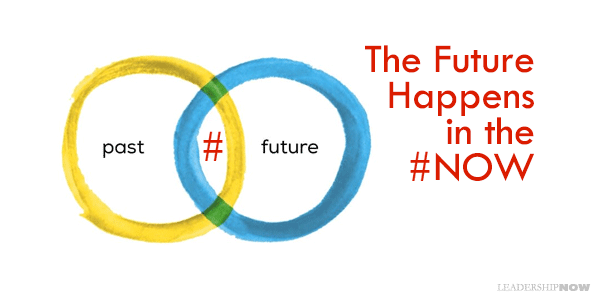
N In #NOW, Max McKeown asks us the think about our now. He says that “for most people, most of the time, it is better to lean towards action than inaction.” People who grab opportunities that are available now, who don’t waste time looking back, and are regret-minimizers, are what McKeown calls Nowists. It is a flexible mindset so we can all learn to become a little more Nowist in our approach. Using Your Past Nowists don’t ignore the past, but they are good at bringing what they want or need from the past to serve them now for the future. They bring “lessons from their previous experiences and good memories” rather than living in the past. One of the reasons that Nowists can see opportunities is that they are not stuck trying to protect their past; spending time and energy on something that no longer makes sense. Functional Impulsivity Nowists don’t act without thinking. That’s dysfunctional. But they do possess a certain kind highly impulsive functional thinking. In a study performed at the University of Michigan on impulsivity, researchers found that there were two impulsive traits. There was the “kind that pushes people to decide quickly in a way that is likely to lead to bad consequences. And the kind that allows people to decide quickly with good results.” Successful Nowists benefit from functional impulsivity. They are good at deciding quickly under pressure and are willing to choose an option even at the cost of making a mistake that they can and are willing to correct as they go forward. Procrastination Nowists take control of their time. Nowists are good “at sequencing their own actions and the actions of others to get to the future on time.” Because they plan, seeing the future as a stream of connected sequences made up of actions and decisions, they can keep their momentum. And because each decision is connected to many actions, they don’t have to make as many decisions. “They can enjoy the pleasure of seeing progress in the past, present, and future, rather than discrete tasks that seem to add up to very little.” You can avoid procrastination by changing your learning to see your future in your present. “Moving the priorities of your future-self into the present can become such a natural perspective that you are more likely to start something as early as possible than waiting too long.” A Nowist leans towards the future from an “active, practical, let’s-make-this-work view of the world.” They only review the past for insights that will help them move forward. They understand cause and effect. “Not everyone sees clear connections between how actions in the past have created the situation in the present, or how actions in the present will shape, or create, the future.” I we can’t make these connections we are “isolated, disconnected and therefore cut off from the power of the #Now.” We all exist in the #Now. It is only in the #Now that we can think, do, or change anything in the future. A Nowist is an active optimist. They believe they can make good things happen and take action to create a better future. Now is a good time to think about your #Now. How will you use your #NOW?  
Posted by Michael McKinney at 02:19 PM
12.25.17

The Best Leadership Books of 2017 by Edward D. Hess and Katherine Ludwig Smart technologies will become ubiquitous, invading and changing many aspects of our professional and personal lives and in many ways challenging our fundamental beliefs about success, opportunity, and the American Dream. New skills will be needed. Uniquely human skills. Those skills, while uniquely human, are not what we are typically trained to do and require a deal of messy personal development. (Blog Post) by Brandon Black and Shayne Hughes “Anytime we know intellectually what to do, but our actual behavior is inconsistent or in contradiction, it is a sign we are being short-circuited by our egosystem. These behavioral derailers come in many forms: conflict avoidance, procrastination, defensiveness, people pleasing, shutting down, being argumentative, just to name a few.” (Blog Post) by Kim Scott Radical candor is a culture of guidance based on caring personally and challenging directly everyone you work with. The goal is to achieve collaboratively what you could never achieve individually, and to do that, you need to care about the people you’re working with. (Blog Post) by Nancy Koehn The crisis that can break one person can give birth to leadership in another. It’s a conscious choice to lead. Koehn brings out key lessons common to Ernest Shackleton, President Abraham Lincoln, legendary abolitionist Frederick Douglass, Nazi-resisting clergyman Dietrich Bonhoeffer, and environmental crusader Rachel Carson, as they struggled with their thoughts in what were do or die situations. (Blog Post) by Ray Dalio Ray Dalio, one of the world’s most successful investors and entrepreneurs, shares the unconventional principles that he’s developed, refined, and used over the past forty years to create unique results in both life and business—and which any person or organization can adopt to help achieve their goals. by Sam Walker The best leaders in sports history were not mesmerizing characters. They didn’t always make for great television. That’s what we’ve come to expect, however. So that’s what we continue to get. And so teams choose the wrong people to lead them. They promote people with the wrong characteristics. It’s typically not the player with the highest market value. What it takes to lead is not always what it seems. (Blog Post) by Rajeev Peshawaria Based on Peshawaria's research spanning 28 countries, he concludes that traditional industrial age thinking needs a massive upgrade to successfully navigating the brave new world of business. Open Source Leadership rewrites the rules of management, giving you a unique look at the most common misperceptions, illusions, and downright wrong information you’ve been getting about what works and what doesn’t. It provides a new, counterintuitive model for seizing competitive edge in any industry. by Lolly Daskal The gap in our leadership arises as a result of the disconnect between how we think people are experiencing our leadership and how they are actually experiencing our leadership. And where we find that disconnect we limit or even derail our leadership potential. (Blog Post) by Nate Regier The misuse of conflict energy is the biggest crisis facing our world, and that we haven’t even begun to harness the creative potential of conflict. When people embrace the fullest meaning of compassion as a process of “struggling with” others in creative conflict, they can transform lives, companies, and the world. (Blog Post) by Raymond M. Kethledge and Michael S. Erwin We live in an age of noise. Getting some time for yourself is a challenge. But if we are going to lead effectively, we need white space. We need solitude. You don’t have to go off to a mountaintop or sit at the seashore. It can be a closed room, the library, a park bench, and even a waiting room. We have a responsibility to seek out periods of solitude. We owe it to ourselves and those we lead. (Blog Post) by Scott Sonenshein Scott Sonenshein dispels the notion that having more resources = getting better results and replaces it with the conviction that a better use of resources = getting better results. Especially in uncertain times, “stretching equips us with the abilities to adapt and change when facing a less predictable set of circumstances.” (Blog Post) by Tasha Eurich Most people feel like they know themselves pretty well. But what if you could know yourself just a little bit better—and with this small improvement, get a big payoff…not just in your career, but in your life? by Brendon Burchard Based on one of the largest surveys ever conducted on high performers, it turns out that just six habits move the needle the most in helping you succeed. Adopt these six habits, and you win. Neglect them, and life is a never-ending struggle. by Chris Fussell with C. W. Goodyear In Team of Teams, retired four-star General Stanley McChrystal and former Navy SEAL Chris Fussell made the case for a new organizational model combining the agility, adaptability, and cohesion of a small team with the power and resources of a giant organization. Now, in One Mission, Fussell channels all his experiences, both military and corporate, into powerful strategies for unifying isolated and distrustful teams. Biographies: by Walter Isaacson Based on thousands of pages from Leonardo’s astonishing notebooks and new discoveries about his life and work, Walter Isaacson weaves a narrative that connects his art to his science. He shows how Leonardo’s genius was based on skills we can improve in ourselves, such as passionate curiosity, careful observation, and an imagination so playful that it flirted with fantasy. by Richard Branson Richard Branson titled his autobiography Finding My Virginity because “You can only lose your virginity once. But in every aspect of my life—building businesses, raising a family, embarking upon adventures—I try to do things for the first time every day.” He shares his ups and downs in his entertaining, candid style. “If your life is one long success story it won’t make for a good read. What's more, you’re most likely a liar. We all have ups and downs, trials and tribulations, failures and triumphs: we just hope to come out stronger on the other side.” (Blog Post) by Sam Zell Billionaire investor Sam Zell has put down on paper an account of the principles that guide how he does business in Am I Being Too Subtle? He advocates an owner/entrepreneurial mindset in business and life. “An owner is consumed with making the most out of what he already has. He’s all in. An entrepreneur is always looking for a new opportunity. He’s always reaching.” (Blog Post) by Ron Chernow “If there were many small things Grant didn’t know about the presidency, he knew one big thing: His main mission was to settle unfinished business from the war by preserving the Union and safeguarding the freed slaves.” Grants example is instructive for us today. Related Interest:
Posted by Michael McKinney at 12:07 AM
12.22.17

Moving Your Agenda
M Samuel Bacharach writes in The Agenda Mover, that leadership is “about your capacity to take your ideas and work them through the maze of resistance, overcome challenges, and put those ideas in place. Leaders are remembered for their accomplishments, not their promises.” To that end, Bacharach has provided a practical guide to do just that. He presents a four-step process that anyone can learn to master with practice. To move an agenda, you need to learn to harness what others have to offer if for no other reason than you have blind spots. You need to build a coalition and develop the managerial skills required to maintain forward movement. It requires a campaign of pragmatic leadership. “Agenda movers are aware that their self-interest, emotions, cognitive capacity, and background can trip them up if they are not careful and that being smart is not a guarantor of success.” 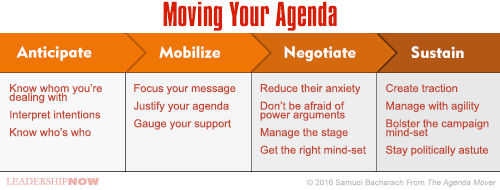 The four major stages in any campaign are first, you must anticipate the agendas of others. Second, you must mobilize your campaign. Third, you need to negotiate buy-in. And fourth, you must sustain momentum. In this post we will focus on the first stage—Anticipate the Agenda of Others—because this is the stage that most of us miss or move too quickly over and set ourselves up for frustration or failure. Anticipate the Agenda of Others This means knowing where others are coming from. Putting yourself in their shoes. Empathy. Our own egos are the enemy here. You need to know who you are dealing with—the stakeholders. Bacharach lists four: Top Dogs (organizational decision-makers), Gatekeepers (the liaisons), Gurus (senior individuals, external consultants, the board of directors), and the Players (people directly impacted by your agenda). The players are your essential ally. Never underestimate them. All of these stakeholders have their own agendas and ways they go about accomplishing them. There are the Tinkerers versus the Overhaulers and the Planners versus Improvisers that make up the Four Agenda Archetypes. There is the Let’s-Be-Careful Traditionalist, the Cross-That-Bridge-When-We-Come-to-It Adjuster, the Push-the-Envelope Developer, and the Tear-the-Envelope Revolutionary. If you know where you are coming from and where others are coming from you can begin to see what might motivate someone to join your change effort. This framework can help you do that. 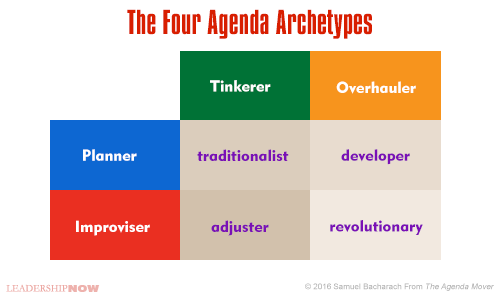 Distinguishing traditionalists from developers, developers from adjusters, and adjusters from revolutionaries allows you to identify where others are coming from quickly and efficiently. In making these distinctions, be careful not to assume that these agendas are immutable or that people are uniformly consistent from one situation to another. Of course, we are a factor in the process. We have our own motivations and our preferred ways of dealing with change. It is critical that we know where we are coming from too. We may need to adjust the approach we are comfortable with in order to move our agenda. The chart below helps you to see how your motivation relates to the motivation of others. “Allies are those who share your agenda, and it is easy for them to see where you’re coming from.” Traditionalists can anticipate that a Revolutionary will resist their approach and agenda. But here is a key insight: Agenda movers are leaders who understand that leading isn’t about meeting jubilantly with allies or reasoning earnestly with resistors. Successful leaders understand that the real challenge is in the gray area—converting potential allies into allies and making sure the potential resistors are not transformed into full-fledged resistors. Potential allies and potential resistors disagree with either your approach or your goals. Skillful negotiation may persuade these individuals to reconsider aspects of your agenda that differ from theirs. If you are not careful, potentials can easily switch to resistors. 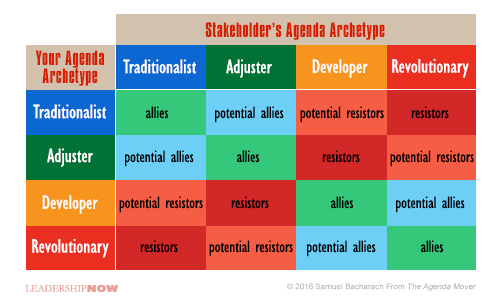 Mobilize Your Campaign Timing and tone make a difference. “To mobilize others you must: focus your message; justify your agenda; establish your credibility; and gauge your support.” You do not want to oversell here. Choose your words carefully to justify why your agenda should be supported. Make sure your idea is well thought through and you demonstrate the ability to see it through. Negotiate Support “Getting the buy-in is about shifting your focus from sharing your passion for your idea to really thinking about where the other party is coming from.” It is a process of reducing their anxiety. How will it benefit them? If they come on board, it is reasonable to assume that it can be done, will they get any of the credit, and are they protected if it fails. They want to know what changes for them. Your approach to the situation will make a big difference. You can approach it with a controlling, hardline mindset if this is a one-time thing. On the other hand, you can try a more cooperative mindset that seeks to pull-them-in. This mindset may allow you to build supporters for any future agenda you may have. Sustain Your Campaign This is where the rubber meets the road. After you’ve won people over, you have to get it done. “You may have sold your idea and created a coalition, but you can only sustain momentum and get results if your team can keep up its energy and focus in spite of challenges, obstacles, and setbacks.” To create traction, you need to celebrate small victories, make sure they own the idea and manage with agility. You have to be smart about how you present yourself and deal with others. You can micromanage your team, but you are better acting as a facilitator coach. To go the distance, your team must act with a collective purpose. You can sustain the campaign mindset by reminding them why they are part of your effort, reinforcing the payoff, keeping an optimistic outlook, and maintaining your credibility. It is crucial to remind people not only about the importance of the mission but also about how important they are to the mission. Anyone successful at moving an agenda knows that it is not a solo effort. “Failed leaders are those who assume that they are the most important player.” The Agenda Mover is a book that leaders at all levels would benefit from reading. It is common to see people trying to push their agenda without first defining what they are up against and without any understanding of the impact they themselves are having on others. Without that knowledge, we often resort to destructive behaviors to get our agenda moving. In that regard, this book is critical for anyone with an idea they want to have taken seriously. 
Posted by Michael McKinney at 12:45 PM
12.20.17

Lead Your Tribe, Love Your Work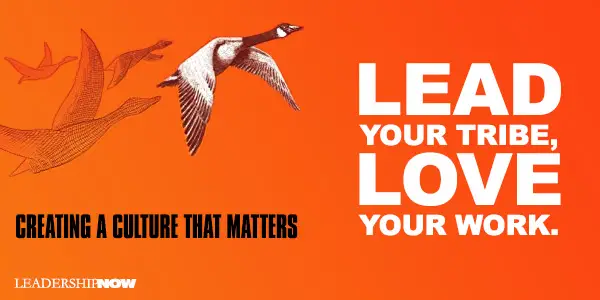
A Piyush Patel, the founder of Digital-Tutors, found himself in just that place after his company began to grow and the sixteen-hour days that were once energizing became draining. Stuck in the weeds, putting out fires, he needed a change. In Lead Your Tribe, Love Your Work, he describes what turned it around for him was defining his values or as he called them, “Rules of Our Game because they were the bare minimum for someone to play on our team.” The five values he and his wife Lisa crafted transformed their company from a place he hated to go into a place he loved to call home. Values, your company’s culture, comes from the heart. They can’t be borrowed or manufactured because they have to be your own. They aren’t something you want to achieve. They are your reality—what you believe. Ask yourself, “What are the rules? What would you never do under any circumstances? A healthy culture has three needs. Belonging. Think of geese flying together. The goal is to make it together. We need to belong to something greater than ourselves. “We want to identify with the people with whom we spend most of our day.” One of the best ways to create that sense of belonging is through shared experiences and company traditions or rituals. Annual road-trips, progressive dinners, Thai Thursdays, having a beer in the break room and other casual activities that create shared memories. Affirmation. “We want to be individually recognized and appreciated in a way that means something to us.” Affirmations are more than just saying thanks. It includes listening, assisting, giving quality time and gift-giving. As important, is making them the hero of the story in front of their loved ones. Taking the time to do these things instills core values into the tribe. Meaning. “We want know what we do makes a difference.” Collect stories of how your organization changes lives. “Meaning goes deeper than just what you do. Meaning goes down into the heart of why you do it.” Meaning goes beyond the transaction with your customers. Make them part of the tribe too. Talk to your people to get a pulse on your culture at least once a week. Just listen and say thanks. Begin by asking questions like: • What’s one thing that makes our culture unique?
Focus on the why and make sure your tribe knows what it is. 
Posted by Michael McKinney at 06:19 PM
12.18.17

Five Happiness Traps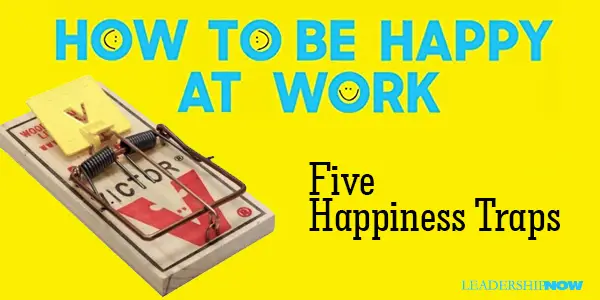
T However, considering the time we spend at work, it should not be a mindless task. Work can be hard, but we should find it invigorating as we rise to meet the challenges and grow our capabilities. Annie McKee shares in How to Be Happy at Work, five happiness traps. They are five traps we fall into that keep us from finding true happiness at work. The Overwork Trap Overwork is very common as we try to keep up with changes, do more with less, work across time zones, escape stress at home, and the sense of importance it gives us. “I’m busy,” is a badge we often wear. McKee quotes Sarah Green Carmichael on this: “We log too many hours because of a mix of inner drivers, like ambition, machismo, greed, anxiety, guilt, enjoyment, pride, the pull of short-term rewards, a desire to prove we’re important, or an overdeveloped sense of duty.” McKee says this overwork is not good for us as it negatively impacts our health and relationships. It keeps us “stuck and striving” and it “shuts down our ability to decipher what we should be doing.” In this state, it’s hard to be happy. First, we must discover why we are working so much. Do we really have to or is it a habit? The Money Trap “Money is great,” says McKee, “until our desire for it overshadows reason.” It’s not always about greed. It’s often deeper than that. “The decision to choose money over happiness is fueled by insecurity, social comparison, and the need to display one’s power for all to see.” We need to tune in to what really brings us happiness in life. “Wouldn’t it be better if money was an outcome that followed our good work rather than a goal in itself?” The Ambition Trap Ambition is not a bad thing until it drives us to be ultra-competitive and focused on winning. When we will do anything, compromise anything to come out on top without regard for the collateral damage, we are in trouble. “First, success isn’t really success when we define it as a win-lose, zero-sum game. Second, hypercompetitiveness in the workplace leaves us empty and unfulfilled, hurts our ability to lead effectively, and makes us no fun to be around. Finally, when ambition and the desire to win at all costs takes over, there’s usually something deeper going on—something we need to examine.” The “Should” Trap We all at one time or another do things because we feel we should even though we don’t want to. Of course, there are things that we should do even when we don’t want to because they are right. But there are “shoulds” that are really not more than expectations placed on us by others or society at large that no longer make any sense. There are “shoulds” that “we are forced to adhere to—whether they are society’s or our organizations’—are truly at odds with who we are and what we believe. That is soul destroying.” Social rules and “shoulds” are a fact of life. It’s not about getting rid of them; it’s about sorting through them and making conscious choices about which to follow—those that enable you to live your values, reach your potential, and be happy. The Helplessness Trap It may sound fatalistic, but as the world continues to change at an ever-increasing pace, there is a sense that we can’t keep up and therefore can’t control what happens to us. When we feel this way, helplessness sets in. “It kills hope, shatters dreams, and leaves us at the mercy of others and the vagaries of our organizations.” It’s easy to feel defeated by life and circumstances. Fear of the unknown makes us feel helpless, but with a bit of courage we can exercise more control over our lives and find happiness at work. Breaking Free from the Happiness Traps Dealing with these happiness traps begins with a little introspection and learning to manage our emotions/feelings. With reflection we can begin to understand why we do and think the things we do, then we can “actively choose to see things differently—to adapt and shift our mindset from negative to a more positive way of viewing ourselves and our situation.” Think about which happiness trap affects you the most. Mckee suggests asking yourself the following questions:

Posted by Michael McKinney at 09:03 AM
12.15.17

Pass Judgment
P We learned this the hard way in NASA Mission Control’s management team. What started as a top executive trusting his senior managers to run their divisions rather than discussing challenges or weak performance in front of their peers, evolved into an expectation to keep your criticisms of the other divisions to yourself. Over time, this evolved even further to not even mentioning any significant issues or challenges in management meetings. The management team mantra became, “No ripples in the pond.” While this led to polite, non-confrontational, and seemingly collegial meetings, it also meant an ever-growing list of cost, schedule, and technical problems that were not being addressed or even on the radar screen of the senior management team running our $650-million/year enterprise. True to the stereotype of government organizations, we had become known as a “marching army” who cost way too much and still did things the way we had for almost 50 years. Our customer program managers were seeking to abandon us and find any other team to turn their spacecraft over to because they had lost faith in our ability to control costs, even though they still considered us to be the best operations team on the planet. Worst of all, most of their criticisms were well founded, and we had become culturally incapable of discussing and doing anything about them as a management team thanks to “no ripples in the pond.” Judgment Can Set an Organization Free Then we looked outside our walls by benchmarking operations teams in several different industries, in both the government and the private sector. We were shocked to find example after example of teams who not only were better than us but also made us look like amateurs in some areas, including some that we considered core competencies. That was the game changer we needed. From that realization, we knew we had to put the “ripples in the pond” and discuss where the organization’s performance was lacking. Choosing otherwise meant that instead of being part of the solution, we were the problem. We started passing judgment rather than hiding from it. We identified management practices that were contributing to our decline and those that we needed to change or implement to improve. The goal then became intentionally performing at the highest level, which we all knew was the intended standard of our high-performing organization all along. We weren’t making personal judgments about each other, but we became adamant in holding each other accountable to this transparent, value-driven, fully engaged style of managing. It set the tone for every discussion whether the decisions entailed our technical work, strategic risk, business management, personnel development, or any subject. Over time, it became a natural part of doing business. We completely upended “no ripples in the pond” with a formal policy of “clarity over diplomacy.” Rather than getting in our way, this level of candor and on-going judgment increased the trust across the team. This genuine and open collegiality also led us to management practices and business strategies we otherwise could not have developed without the talent and experience from across the full management team. As just one measure for how that affected organizational performance, in the course of two years we were able to reduce total costs to our customers by half while performing the same work and still delivering the expected high-quality support. Judgment Can Enable Personal Growth Learning to pass judgment about team behaviors is one thing, doing the same individually can still be a challenge. A respected senior executive once told me, “Nobody’s any better or worse, really. They’re all about the same talent level. There’s nothing you can really do as a manager to change that.” In practice, this individual version of “no ripples in the pond” feels nice because it avoids the discomfort that can accompany passing judgment. But it also keeps us stuck, because, of course, we are not all the same. We all have different strengths and different weaknesses, and top performance requires us to first understand both. In the same way that benchmarking helped our management team, personality assessments (Myers-Briggs, Birkman, DISC, etc), feedback, and executive coaching are all great tools for gaining insights into our individual strengths, weaknesses, and how we affect others because of them. With that awareness, we can then make judgments about which of our behaviors help the organization be successful and which get in the way. Rather than being critical, these judgments are aligned to the team’s success, and with them, we can choose to deliberately improve. See The Ripples in the Pond The ripples are already in the pond in everything we do. The question is: Are we willing to acknowledge them and proactively do something about them? High-performing teams and individuals do not ignore the ripples in the pond – the indicators of problems that could erode success and lead to failure. They learn to see them and do something about them. That requires passing judgment, but this isn’t about judging individual worth. It is about judging our behaviors and how well aligned they are to the team’s success. With that understanding, critical judgment becomes less threatening, and the actions required to improve likewise become easier to identify and implement. From those judgments, the highest performing teams are able to harness the strengths from across the team, while also working around or improving each of our individual weak areas. They are then best equipped to handle challenges and identify opportunities. That’s leading.    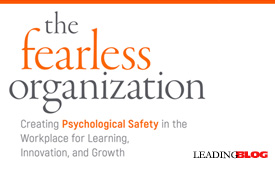
Posted by Michael McKinney at 07:19 AM
12.13.17

Commanding Excellence with Purpose, Passion, and Ingenuity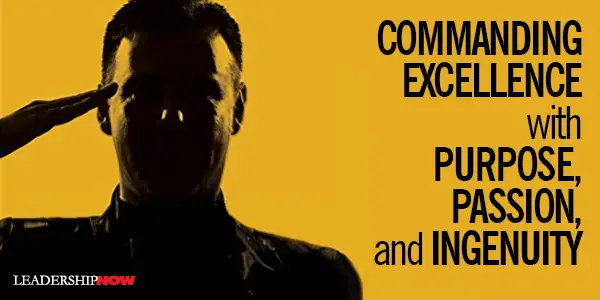
G Commanding Excellence describes how these two leaders led their respective organizations to incredible success. Fred Dibella says the account is “about everyone signing up and them pulling their weight, so the whole becomes greater than the sum of its parts.” What made these organizations stand out was the simplicity of their leadership driven by an absolute clarity of purpose, empowered obsession, and unleashed creativity. Morton illustrates how each of these was manifested in these organizations. Absolute Clarity of Purpose The first all-important question to ask is, “What are we trying to achieve?” After that, all distractions were eliminated or deliberately de-emphasized, and a playbook was developed to codify the mission. “Success would not come from devising an ingenious plan for each battle but from hard work in executing the six simple plays that relied on disciplined execution.” Having this kind of clarity simplifies managing. In most cases, decisions did not require higher-level endorsement; the purpose served as a guide. What made it work is that everything was structured around the mission. There was accountability at every level as lines of authority were drawn, “first and foremost, for maximal effectiveness in combat, and, second, for effectiveness in training and preparation. The mission-focused structure was decentralized from the standpoint that each commander was given great freedom to execute, but they were also expected to cooperate with the decentralized companies and share everything with other teams. Morton credits the structure working because it was developed and built around strengths. “Dibella did not believe that all men do all things well, and he felt it was foolhardy to ask them to do so.” Brown did the same thing at Stryker with his 20-percent annual growth goal and the mantra: Invent it, make it, sell it. “Everyone in the organization knew the goal, acknowledged how important it was to the organization, and understood how they could contribute to the achievement.” Empowered Obsession Clarity isn’t enough. “Clarity was the foundation, but the walls and roof were built around shared obsession.” Brown and Dibella drove this obsession. They were both “seriously afflicted by an absolute, monomaniacal obsession, and spreading that obsession throughout the organization—every person, process, and method of measuring anything meaningful—was central to their leadership.” Everyone felt a deep personal ownership of the goal and knew that their actions were absolutely essential to attaining it. What you did mattered and it was rewarded. Stability in the teams was important. 4-68 leadership determined that “gains from stability—mainly unit-to-unit and soldier-to-soldier relationships—would trump any gains that might come from tailoring the organization for a particular mission.” Morton notes that “Greatness may require all-star talent, but only when a group of talented individuals is stabilized and able to bond into a cohesive team over time so they deliver their top performance.” Unleashed Creativity Clarity of purpose provided the why. Obsession delivered the high-performance. And unleashed creativity made it possible. Ingenuity was essential. “The thirst for better ways of doing things was deeply interwoven into the organizational mindset.”
Rank plays no part here. Ideas are elevated on their merit. Dibella “embraced every new idea that moved us closer to the goal.” In each organization, their purpose required radically different methods and new thinking. “Both leaders exhibited a considerable understanding for mistakes of the mind but little for mistakes of the heart.” 
Posted by Michael McKinney at 07:54 AM
12.11.17

There's a Password for Every Door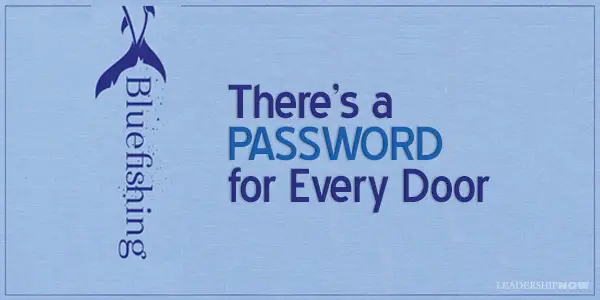
H How does it feel to not be afraid? Steve Sims, the founder of Bluefish, has built a company that gets things done. Bluefish makes seemingly out-of-reach, change-your-life, experiences happen. Experiences like training with the Navy Seals, singing with your favorite band, watching Formula 1 in Monaco with royalty, having a private dinner at the feet of Michelangelo’s David while being sung to by Andrea Bocelli, and being James Bond for the weekend. He calls it bluefishing. Bluefishing is about changing your mindset. It’s about looking at life differently. “You can’t cower your way through life and hope to succeed; you’re going to have to stick your neck out a little.” We usually sell ourselves short. “Anything I wasn’t achieving in life, any doors that were closed to me, I could figure out the password for.” It’s about understanding what someone wants and finding the right key for each door. Bluefishers look for connections. What are people passionate about and how can I find a win-win for their passions? Passion is something you have to discover—your own and others too. Bluefishers question everything. They don’t doubt, they question. Read between the lines; get behind the façade. Drill down for it. Ask why at least three times. “The first why is what they think they think, the second why is what they think you want to hear, the third why is why they feel.” If you go in there with the idea that it’s going to fail, or that you’re asking too much, or you’re giving something the person doesn’t really want, you might as well not even go. You’ve gotta go in there knowing that this is really going to happen, but understanding that it’s not going to happen if it benefits only you. It’s not about how much you know. “I don’t need to know how to do the whole event,” says Sims. “The first thing I need to know is which things I can’t do. The next thing is to find those people who can do what I can’t. I just find the ones who are good enough at doing what I can’t to make me look brilliant.” Entrepreneurs should take note: You shouldn’t try to do everything, just “be able to magnificently orchestrate those who can.” You grow by giving others responsibility. “There’s a difference between being able to do everything and doing everything.” Lead the orchestra. “All you want is to find a whole bunch of people with unique abilities, all with their own 5 percent traits or skill that no one else can do. That’s how you build up an irreplaceable team. A dream team.” Don’t spend time on things that slow you down. Don’t overthink everything. Try something and fail at it over and over until you find out how to do it properly—to see if it is worth pursuing—while everyone else is still trying to work out the demographics. Sims Dad told him, “No one drowned from falling in the water. They drowned from staying there.” Don’t stand still. When you don’t succeed, it isn’t a failure. It is discovery. Failure is final. Discovery is just the beginning. “You didn’t fail. You learned what to do on your next attempt.” It’s an education. “If you build up obstacles in your head, you’re looking for a reason to end it.” That’s failure. To build your brand, first, do a self-audit. What do you stand for? How do you want people to feel when they are around you? Discover your strengths and manage your weaknesses. “Focus on the smallest element that can bring you down. Focus on your own weak links, the things that foul up your life or your work again and again and again.” Forget about counting likes. If you tell people how good you are, that’s just selling. Get others to talk about you—recommend you. “What brands need to do—both personal and business brands—is ask other people to validate the truth.” Focus on the community you’re building around you. Invest in your growth. Get better for your clients—your followers. And let them know. Sims told a friend, “Mate, the only difference between you and me is that I was willing to get into uncomfortable situations. I was willing to look dumb, to be among people that I knew were far more intelligent than me, so that I could learn. There’s no reason to get into a room with people stupider than you.” When you expose yourself to something new, you never go back. Be a sponge. Sims shares techniques to support the thinking but the tactics change over time. The thinking never does. Bluefishing is a mentality first, then a stack of tools and behaviors. Learn the password and the doors will open. 
Posted by Michael McKinney at 07:44 AM
12.08.17

The Stand-Up Strategists
H Skilled leaders, those we call the “Stand-Up Strategists,” understand the utility of humor to address four important organizational outcomes, or the 4Cs: Community, Composure, Change and Creativity. And to address these four outcomes they typically use four broad styles of humor. The 4S – Styles of Humor The four styles we identified are based on our understanding of humor-driven dynamics in organizations, and build upon the broader world of humor research: Sensory humor involves a leader projecting an energetic, positive, playful vibe, and having a generally humorous outlook. Social humor typically involves jokes or stories shared as a tool to reduce interpersonal tension, increase sociability and promote openness. Self-deprecating humor is the ability of a leader to laugh at him/herself to reduce power-distance, and thereby facilitate more positive and intimate relationships. Strong humor most often entails sarcasm or cynicism. It is the comic style mostly associated with generating negative emotions, and therefore the one with the most limited application in organizations. The 4Cs – Organizational Outcomes There are four organizational outcomes where humor can be leveraged as a particularly effective managerial tool: Community In situations in which collaboration is an important driver of organizational success, lacking a sense of community can be a formidable barrier to delivering results. It is well understood by psychologists and social scientists that people who laugh together generally have stronger feelings of empathy and bonding. Sense of fun and social humor can be used as especially effective humoristic styles to build group cohesiveness, with a leader as the role model of projecting a relaxed and humorous attitude, sharing occasional jokes, anecdotes and stories that inject a playful aspect to day to day interactions. In situations where a leader needs to increase sociability across organizational hierarchies, self-deprecating humor can also be used. In years gone by, strong 'community' humor might have involved humiliation, ridicule, sexist or even racist overtones but these kind of jokes, anecdotes and stories have no place in today’s world. Beyond being potentially damaging to one’s own reputation, inappropriate humor can also contribute to reduced morale, absenteeism, the elevation of dysfunctional internal competition, and company-level reputational damage. Composure Studies on humor, stress and coping strategies have shown that individuals with a high sense of humor tend to experience less stress than individuals with a low sense of humor, even in situations where both face similar challenges. In group situations, humor can be utilized to reduce the pressure of stress associated with deadlines, targets or crises. Social humor is best leveraged in these situations, not to make deadlines or challenges disappear, but to improve morale, to help individuals avoid feelings of isolation, and to increase the solidarity of purpose needed to overcome adversity. Due to its tendency to trigger negative emotions, strong humor should be used sparingly, and in most instances only ever directed at external targets where there is an urgent need to overcome complacency or strong internal inertia. Change It is important for all leaders to communicate with employees about ongoing organizational change, especially with regards to vision and strategic priorities. Humor in day-to-day interactions and broader organizational communication can create an atmosphere which improves listening and understanding, boosts message retention, and enables positive emotions. These outcomes are even more vital during times of continuous change - two of the most common reasons that employees resist change are lack of sufficient information and a fear of the unknown. In the words of writer and civil rights activist Maya Angelou: “I’ve learned that people will forget what you said, people will forget what you did, but people will never forget how you made them feel.” Creativity The fourth organizational condition addressed by humor is perhaps the most important: creativity. Humor, laughter and fun releases physical and cognitive tension, which can lead to perceptual flexibility—a required component of creativity, ideation, and problem solving. Discoveries in this area also explain why many leaders are not just leveraging humor, but are also investing in creating playful and fun work environments. Jumping to conclusions… Time and time again in our interactions with leaders in some of the world’s most successful and innovative companies we have been struck by a recurring experience – not only are these leaders intelligent, talented and forward-thinking, many of them are also very funny. And it is not just that these senior executives are able to deliver a flawless punchline at a cocktail reception or town hall event – they are able to leverage humor as a strategic tool. May the farce be with you!  Of Related Interest: “When you’re a high performer, when you’re an achiever, the doors open in front of you.” “It’s great to strive for success, to shoot for the moon. But there are many moons out there in the Universe, so please make sure that the moon you are shooting for is your own.”
Posted by Michael McKinney at 08:02 AM
12.06.17

12 Lessons for Entrepreneurs from Richard Branson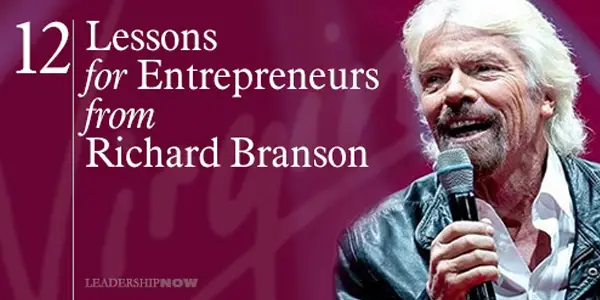
R In Finding My Virginity, Branson shares his ups and downs in his entertaining, candid style. “If your life is one long success story it won’t make for a good read. What's more, you’re most likely a liar. We all have ups and downs, trials and tribulations, failures and triumphs: we just hope to come out stronger on the other side.” What follows is some sound advice Branson shares about what it means to be an entrepreneur. Work Fast Generally, we like to work fast: try ideas, see if they stick, and, if they don’t, quickly move on to the next one. I work best when my mind is able to jump from one topic to the next in quick succession. It keeps things lively, and it’s amazing how often good ideas for one company come out of another completely unrelated business. Listen Too many people presume they are right and don’t listen to other points of view. They speak categorically and then close their ears. I consider myself a good listener and apportion a good deal of my success—not to mention my marriage—to this. Some entrepreneurs surround themselves with brilliant people and then ignore them. Most people who behave in this autocratic way get their comeuppance. I know I am not better than anyone else, so I take a different road. Value of Entrepreneurs It may be controversial to say it, but there is no job more important than being an entrepreneur. When you analyze everything about the world and all the improvements that get made, almost without exception, it is an entrepreneur that has made them. It might be an entrepreneurial doctor, or architect, or artist—anything. While business may have changed from when I started out, the principles are the same and still fit what I am good at: finding markets that need shaking up, coming up with ways to make people’s lives better, then finding brilliant people to bring it to life. Once an entrepreneur, always an entrepreneur. Invest in People What I am good at is coming up with interesting ideas and then finding amazing people to turn them into reality. I see investing in start-ups in the same way. I’m not always caught up in the details of what a particular app will or won’t do; I’m more interested in the personalities behind the companies, and the purpose within their visions. I’d happily invest in a company that ends up failing in order to find a young entrepreneur who will go on to change the world. Youthful Spirit I have seen so many companies come and go, largely because they didn’t reinvent themselves. They stayed in a sector that had died, whereas Virgin was always one step ahead of the game. Most people think: know your onions, then stick to them. My worry is that people will get bored of onions and move on to carrots instead, putting your onion out of business. No matter what is happening in my business life, regardless of what situation my companies are in, somewhere in the back of my mind I will be mulling over a new idea. I like to think it is my curiosity and thirst for fresh inspiration. I think entrepreneurship is our natural state—a big adult word that probably boils down to something much more obvious like playfulness. When we are young, before we have our childlike wonder beaten out of us by adult life, we are at our most inventive and ambitious in our actions. I’ve always tried to keep that youthful spirit. Now, it’s absolutely critical to keep that early hunger I had. I mustn’t get complacent; I’ve still got to be fleet of foot and quick to jump upon opportunities. Tell Stories Having the facts on your side is one thing, but telling a great story with just enough charm and chutzpah can make all the difference. Get Help Asking for support is a strength, not a weakness. If you try to do everything yourself, you won’t succeed and will make yourself miserable along the way. Note-Taking Virgin has a note-taking culture and I’m certain it wouldn’t be the success it is today without it. I jot down ideas, thoughts, requests, reminders and doodles every single day; if I didn’t I would forget them before I could ever put them into action. Making lists is both a way of remembering things and of ticking off achievements to make progress. Without notes and follow-ups, chances are nothing would get done. If somebody works for me and doesn’t take notes, I ask them: “Are you too important? Note taking isn’t beneath anyone.” I take notes in every meeting, to keep the frame of mind to learn. I edit as I go along, and follow up with dates and tasks in order of importance. Encourage Ideas Any manager who punishes their staff for expressing an opinion hasn’t got the faintest idea about leadership. People in charge should empower their employees, not scare them into silence. Value People I have always thought it refreshing, and sensible, for leaders to get right among their people. That way you get to know them, hear their ideas, build stronger ties and create relationships in a way you never can sealed off behind a closed door. The word “family” gets used too often by companies who treat their staff as anything but. I wish more businesses really did run like families. When things are going well, everyone has an even better time celebrating together. When things are tough, you can rally around and help each other get through it. Making It Work Sometimes it is necessary to pivot a business into a new idea, and wait for another opportunity. Leadership The way to become a great leader is to look for the best in people—seldom criticize—always praise. 
Posted by Michael McKinney at 08:09 AM
12.04.17

10 Questions to Ask Your Employees Every Quarter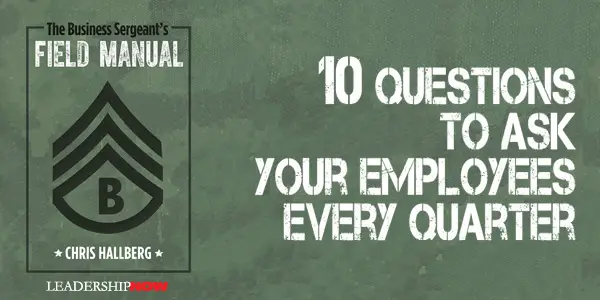
M Strong leaders, on the other hand, happily ask these questions with an eye on making things better for their team. When everyone is heard and acknowledged, only then can a leader make the right decisions and give each employee what he or she needs. If you don’t ask, who will? 1. What is your overall satisfaction with your team?
2. If the best place you’ve ever worked was a 10, please rate your current company.
3. How well does your leader do with supporting and developing you? (Consider time, tools and training.)
4. How well does your leader hold you accountable?
5. How well does your leader hold OTHERS accountable?
6. How well does your leader communicate with you?
7. How likely are you to recommend your company to a friend that is looking for work?
8. Rate your team “health.”
9. Do you feel adequately recognized for your contributions to the team?
10. How likely are you to seek advancement at your company?
The sum of all of these questions together will give you valuable information on where you are doing well and where needs immediate attention. If you ask these 10 questions every 90 days, you can compare your team’s last quarter responses and spot any problem areas before things get too caustic to your beloved culture. Again, if you don’t ask, you are guessing, and that might not work out well for you, or for your team!  
Posted by Michael McKinney at 08:05 AM
12.01.17

First Look: Leadership Books for December 2017Here's a look at some of the best leadership books to be released in December.    
For bulk orders call 1-800-423-8273  Build your leadership library with these specials on over 39 titles. All titles are at least 40% off the list price and are available only in limited quantities. "A capacity and taste for reading gives access to whatever has already been discovered by others." — Abraham Lincoln
Posted by Michael McKinney at 07:22 AM
|
BUILD YOUR KNOWLEDGE


How to Do Your Start-Up Right STRAIGHT TALK FOR START-UPS 
Grow Your Leadership Skills NEW AND UPCOMING LEADERSHIP BOOKS 
Leadership Minute BITE-SIZE CONCEPTS YOU CAN CHEW ON 
Classic Leadership Books BOOKS TO READ BEFORE YOU LEAD |
|